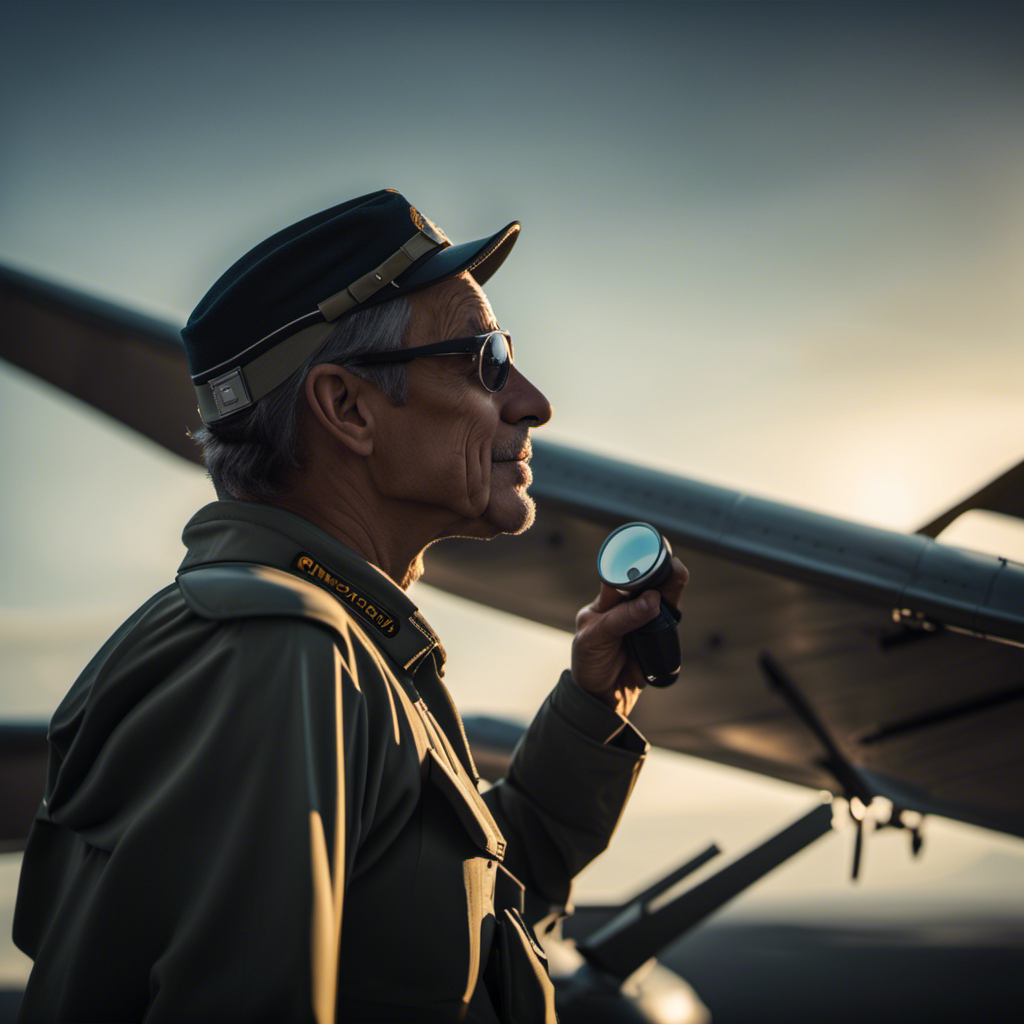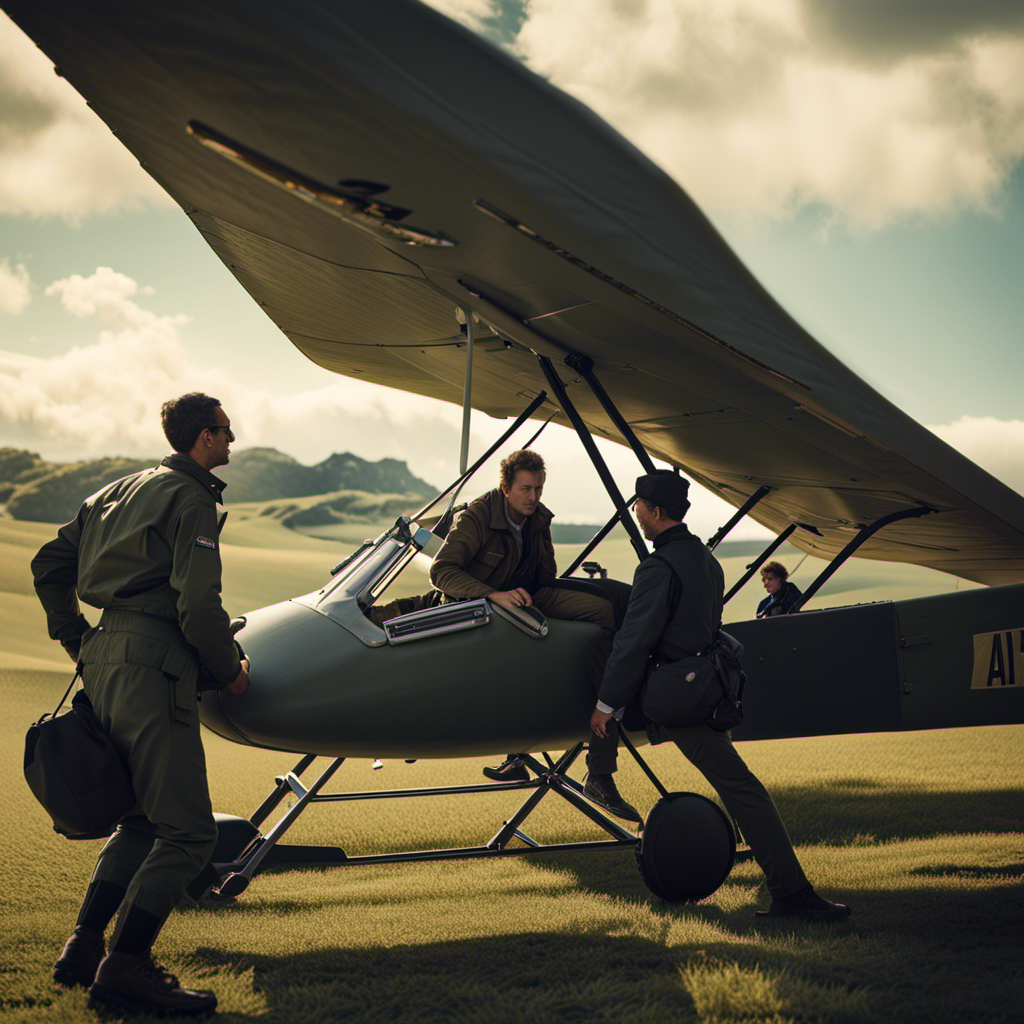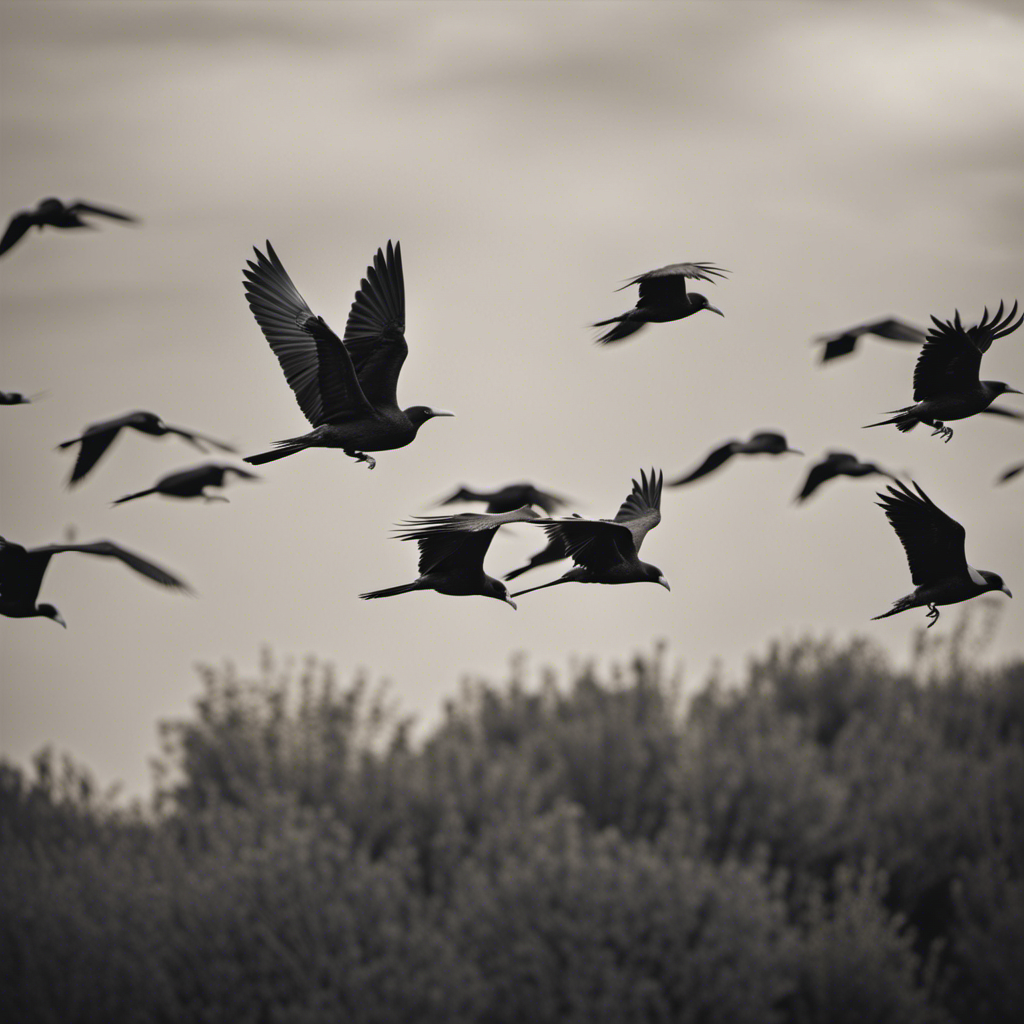As a seasoned glider pilot, I understand the importance of following key safety precautions on each flight.
Did you know that regular maintenance checks can significantly reduce the risk of mechanical failures in gliders?
In this article, I will share essential tips and precautions that will help you maintain a high level of safety while soaring through the skies.
From conducting thorough pre-flight inspections to staying updated on weather conditions, I will guide you through the meticulous process of ensuring glider safety.
Key Takeaways
- Meticulously designed protocols and standard operating procedures are essential for minimizing risks and maximizing safety in glider flying procedures.
- Clear communication with air traffic control, including updating and relaying important information, is vital for safe glider flight and efficient navigation.
- Following ATC protocols ensures smooth and conflict-free glider flight, helping to avoid potential conflicts with other aircraft and adjusting course if necessary.
- Staying alert and vigilant, continuously improving skills through training programs and educational resources, and being prepared for emergencies are crucial for ensuring glider safety.
Perform Regular Maintenance Checks on the Glider
You should always make sure you perform regular maintenance checks on your glider to ensure its safety. Glider maintenance is crucial in order to prevent any potential issues that could compromise the safety of your flight. As an experienced glider pilot, I understand the importance of taking meticulous care of my aircraft.
Safety precautions should be taken seriously, and regular maintenance checks are a fundamental part of ensuring the glider’s reliability. It is imperative to inspect the glider’s structure, including the wings, fuselage, and control surfaces, for any signs of damage or wear. Pay close attention to the canopy, as any cracks or chips could lead to structural failure during flight.
Additionally, it is essential to inspect the glider’s control systems, such as the ailerons, elevators, and rudder, to ensure they are functioning properly. Check for any loose or worn parts that may need to be replaced. Lubricating the control systems regularly will also help maintain their smooth operation.
Conduct a Thorough Pre-Flight Inspection
Before takeoff, it’s crucial to conduct a thorough pre-flight inspection of the glider. As an experienced pilot, I understand the importance of following a pre-flight checklist and adhering to proper safety procedures. This meticulous process ensures that the glider is in optimal condition for flight, reducing the risk of any potential issues.
When conducting a pre-flight inspection, I begin by visually inspecting the entire glider, checking for any signs of damage or wear. I pay close attention to the wings, control surfaces, and landing gear, ensuring that they are all secure and functioning properly. I also inspect the cockpit, checking the instruments, controls, and safety harnesses.
Next, I move on to the mechanical components of the glider. I carefully inspect the cables, connectors, and hinges, looking for any signs of fraying or excessive wear. I also check the fuel system, ensuring that it is properly sealed and free from any leaks.
Ensure Proper Weight and Balance Distribution
It’s crucial to maintain proper weight and balance distribution in the glider to ensure a safe and stable flight. Proper weight management is essential for a glider pilot, as it directly affects the performance and maneuverability of the aircraft. Excessive weight can reduce the glider’s ability to climb, while insufficient weight can make it difficult to control during flight. Achieving the correct balance distribution is equally important. By distributing the weight evenly between the wings, the glider remains stable and responsive to pilot inputs.
To achieve proper weight and balance distribution, pilots employ various techniques. One common technique is to adjust the position of heavy objects, such as batteries or fuel, to find the optimal balance point. Additionally, pilots may need to redistribute their own weight by adjusting their seating position or using ballast bags. By diligently applying these balance distribution techniques, pilots can ensure that their glider is in optimal condition for a safe and enjoyable flight.
Ensuring proper weight and balance distribution is just one aspect of glider safety. Equally important is the use of quality safety equipment and gear. By using reliable and well-maintained equipment, pilots can minimize the risk of accidents and injuries.
Use Quality Safety Equipment and Gear
Using reliable and well-maintained equipment and gear is crucial for ensuring a safe and enjoyable glider flight. As an experienced glider pilot, I know the importance of quality assurance and adhering to safety standards. Here are three key reasons why using quality safety equipment and gear is essential:
-
Protection: Investing in high-quality safety equipment, such as helmets, harnesses, and emergency parachutes, provides optimal protection in case of any unforeseen circumstances. This ensures that you are well-equipped to handle emergencies and minimize the risk of injuries during flight.
-
Reliability: Good quality equipment is built to withstand the demands of glider flying. It undergoes rigorous testing and meets industry standards, giving you peace of mind knowing that your gear is dependable and won’t fail you during critical moments.
-
Enhanced Performance: Using top-notch equipment not only ensures safety but also enhances your overall flying experience. High-quality gear, such as well-designed instruments and comfortable cockpit seats, can improve your control and maneuverability, allowing you to fully enjoy the thrill of gliding.
As a responsible pilot, I understand the importance of staying updated on weather conditions. By monitoring weather patterns, wind speeds, and turbulence forecasts, I can make informed decisions about when and where to fly. Weather conditions play a significant role in glider flight safety, and staying informed helps me avoid potential hazards and plan my flights accordingly.
Stay Updated on Weather Conditions
To stay safe during your glider flight, you need to regularly check and monitor weather conditions. Weather plays a crucial role in gliding, affecting wind patterns, thermals, and flight stability. Monitoring forecasts is vital to make informed decisions before taking off. Keep an eye on factors such as wind speed, direction, cloud cover, and potential storms or turbulence. Seek advice from experienced glider pilots or meteorologists for valuable insights.
Being knowledgeable about weather conditions allows you to plan your flight route, avoiding areas with unfavorable conditions or hazards. It also helps you decide when to launch and land for optimal conditions. By staying updated on weather conditions, you can minimize risks associated with unexpected changes.
Transitioning to following standard operating procedures and guidelines, it is crucial to complement your weather monitoring with adherence to safety protocols. By doing so, you can enhance your overall glider flight experience while mitigating risks.
Follow Standard Operating Procedures and Guidelines
Make sure you follow the standard operating procedures and guidelines to ensure a smooth and safe glider flight. Compliance with safety regulations is of utmost importance when it comes to glider flying. As an experienced glider pilot, I can’t stress enough the significance of adhering to these procedures. Every step and every rule is put in place to ensure the safety of both the pilot and any passengers on board.
From pre-flight inspections to in-flight protocols, each procedure is meticulously designed to minimize risks and maximize safety.
Teamwork is another crucial aspect of glider flying. It involves effective communication and coordination between the pilot, ground crew, and air traffic control. The success of a glider flight relies heavily on the collaborative efforts of each team member. Everyone needs to be aware of their responsibilities and work together seamlessly. This not only ensures the safety of the flight, but it also enhances the overall experience for everyone involved.
Maintaining clear communication with air traffic control is vital in ensuring a safe glider flight. By constantly updating and relaying important information such as position, altitude, and intentions, air traffic control can provide guidance and alerts to avoid any potential conflicts with other aircraft. This open line of communication allows for efficient navigation and helps prevent any misunderstandings or potential hazards.
To summarize, following standard operating procedures, complying with safety regulations, and emphasizing the importance of teamwork are all essential for a safe glider flight. By doing so, we can create a secure environment and maintain clear communication with air traffic control, ensuring a successful and enjoyable glider experience.
Maintain Clear Communication with Air Traffic Control
Maintaining clear communication with ATC is crucial for a smooth and safe glider flight. As a seasoned glider pilot, I understand the importance of following air traffic control protocols and practicing clear communication practices. By adhering to these guidelines, I can ensure that my flight is not only efficient but also free from potential conflicts with other aircraft in the airspace.
To maintain clear communication, I rely on a set of established protocols. These protocols help me effectively communicate with air traffic control and receive important information about traffic, weather conditions, and any potential hazards. By staying in constant contact with ATC, I can make informed decisions during my flight and adjust my course if necessary.
Here is a table summarizing the key components of clear communication practices and air traffic control protocols:
| Clear Communication Practices | Air Traffic Control Protocols |
|---|---|
| Use proper radio etiquette | Follow assigned frequencies |
| Speak clearly and concisely | Acknowledge instructions |
| Listen actively | Report position and intentions |
| Confirm instructions | Follow traffic pattern rules |
Stay Alert and Vigilant during the Flight
Staying alert and vigilant throughout the flight is crucial for maintaining a high level of situational awareness. As a glider pilot, concentration during flight is of utmost importance, and avoiding distractions is a key aspect of ensuring safety. I have learned through my years of experience that maintaining focus on the task at hand is essential for a successful flight.
The moment I step into the cockpit, my mind shifts into a state of heightened awareness. I pay close attention to my surroundings, constantly scanning for potential hazards, and making quick decisions based on the ever-changing conditions. Any distractions, whether it be a buzzing phone or engaging in idle conversation, can compromise my concentration and put myself and others at risk.
By prioritizing flight concentration and avoiding distractions, I can maximize my situational awareness and ensure a safe flight.
Transitioning into the next section about continuously improving skills through training and education, it is vital to recognize that staying alert and vigilant is just the first step in maintaining safety. To further enhance my abilities as a glider pilot, I continuously seek opportunities to expand my knowledge and skills.
Continuously Improve Skills through Training and Education
Transitioning into the next section, it’s important to continuously improve skills through training and education. As a glider pilot, I understand the significance of staying updated and honing my abilities to ensure a safe and successful flight. By investing in training programs and educational resources, I can enhance my skills and stay ahead of any challenges that may arise.
To emphasize the importance of continuous improvement, let’s take a look at the following table:
| Benefits of Improving Skills | Training Programs | Educational Resources |
|---|---|---|
| Enhances situational awareness | X | X |
| Improves decision-making abilities | X | X |
| Boosts confidence and self-assurance | X | X |
| Enhances technical knowledge | X | X |
| Reduces the likelihood of accidents | X | X |
By participating in training programs and utilizing educational resources, pilots can reap these benefits and ensure a safer flying experience for themselves and their passengers.
As we transition into the subsequent section about staying calm and composed in emergency situations, it is crucial to understand the importance of maintaining a focused mindset.
Stay Calm and Composed in Emergency Situations
When faced with emergency situations, it’s important to remain calm and composed in order to make rational decisions and ensure the safety of all involved. Maintaining mental resilience is crucial for an effective emergency response.
As a seasoned emergency responder, I understand the significance of staying level-headed in high-pressure situations.
In my experience, maintaining mental resilience begins with proper training and preparation. By regularly practicing emergency response protocols, I have developed a sense of confidence and readiness that allows me to remain composed in the face of chaos. This preparedness enables me to think clearly and make quick, yet calculated decisions.
Additionally, I have found that self-awareness and emotional regulation are key factors in maintaining mental resilience. Understanding my own reactions and emotions during emergencies allows me to manage them effectively, preventing panic from clouding my judgment. Taking deep breaths, focusing on the task at hand, and reminding myself of my training all help me stay calm and composed.
Furthermore, effective communication plays a significant role in an emergency response. Clear and concise instructions, delivered with confidence, help to instill a sense of calm and assurance among those involved. By maintaining a composed demeanor and projecting confidence, I can effectively convey information and coordinate efforts to ensure the safety of everyone involved.
Frequently Asked Questions
What are the common maintenance issues that gliders face?
Common glider repair issues include worn-out cables, damaged or bent control surfaces, and worn-out or damaged landing gear. Regular inspections, lubrication, and replacement of worn-out parts are essential glider maintenance tips to ensure safe and smooth flight.
How often should a glider undergo maintenance checks?
Glider maintenance frequency depends on various factors, but a general rule is to conduct regular checks every 100 flight hours. It’s important to follow a comprehensive glider inspection checklist to ensure safety and address any potential issues promptly.
What are the essential components of a pre-flight inspection for gliders?
Ah, the pre-flight inspection, a delightful chore that never fails to excite me. First, I meticulously check the glider’s components, ensuring everything is in tip-top shape. Then, I carefully assess weight and balance distribution, because who needs stability?
How can one ensure proper weight and balance distribution in a glider?
To ensure proper weight distribution and balance maintenance in a glider, I carefully calculate the weight of all components, including passengers and cargo. I then make adjustments as necessary to achieve optimal performance and stability during flight.
What are the recommended safety equipment and gear for glider pilots?
As a glider pilot, it is crucial to have top-notch safety equipment and gear. Glider pilot training ensures that we are equipped with the necessary tools to handle any situation. Additionally, understanding the importance of weather conditions is paramount for a safe and successful flight.
Conclusion
In conclusion, it is important to prioritize the safety of your glider. By following these precautions and maintaining a meticulous approach, you can minimize the risk of accidents and emergencies.
Some essential factors to consider include regular maintenance checks, thorough pre-flight inspections, proper weight distribution, and the use of quality safety equipment.
In addition to these measures, it is important to stay updated on weather conditions, maintain clear communication, and continuously improve your skills through training and education.
Remember, staying calm and composed in emergency situations is key. So, buckle up and soar through the skies with confidence and peace of mind.
With a heart that soars as high as the skies, Aria, affectionately known as “Skylark,” is the driving force behind Soaring Skyways. Her journey into the gliding world began as a young dreamer gazing up at the soaring birds, yearning to experience the weightlessness and freedom they embodied. With years of experience both in the cockpit and behind the scenes, Aria’s commitment to the gliding community is unwavering.










